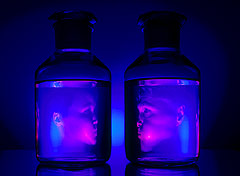| |
|
I kicked at open doors when I presented
my idea for this story to GEO magazine.
Originally, I had planned a wider approach
to all the various aspects of ‘water’.
I spent one whole month on the phone
doing research on water supply of remote
places, diviners, historical water pipes
and a couple of rather dubious side tracks.
But I somehow lost track of things in
the
abundance of information I had gathered.
GEO photo director Ruth Eichhorn saved
me by suggesting I concentrate on water
treatment and research only. After another
three months on the phone I came up with
a list of the most interesting things and
places I wanted to photograph and GEO
gave me the green light.
In the summer of 1999 I went on a two-
week tour throughout Germany with my
assistant Astrid Bärndal, followed by
several smaller trips in autumn, so that
|
|
the field work on the story finally added up
to a total of four weeks.
The problems we encountered were the
same anywhere we went: How to give some
life to water treatment facilities whereas the
absence of life – either human or microbial –
is a defining trait of these very facilities
because most of them run fully automated?
How to visualize water that is mostly hidden
from view inside pipes and tanks?
I climbed over the side of a tall dam,
secured by a climbing harness. I had myself
lowered into a 50m-shaft with a crane.
We spent nights in noisy machine rooms,
suspiciously eyed by maintenance personnel
who didn’t understand what the heck we were
doing there. We donned protective suits to
avoid exposure to radiation. Etc, etc.
And all this to show how our most vital
and common resource is provided: tapwater.
|


